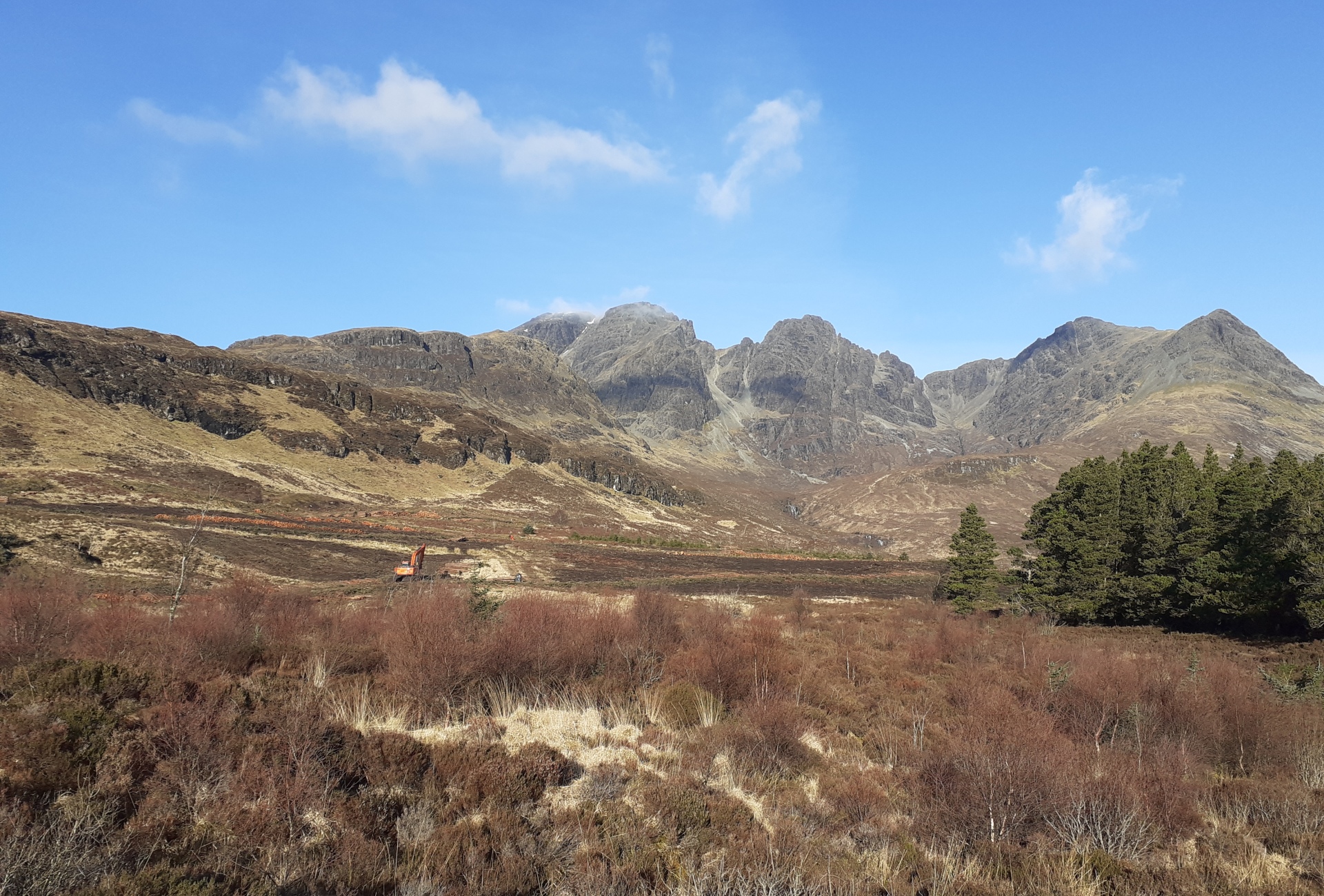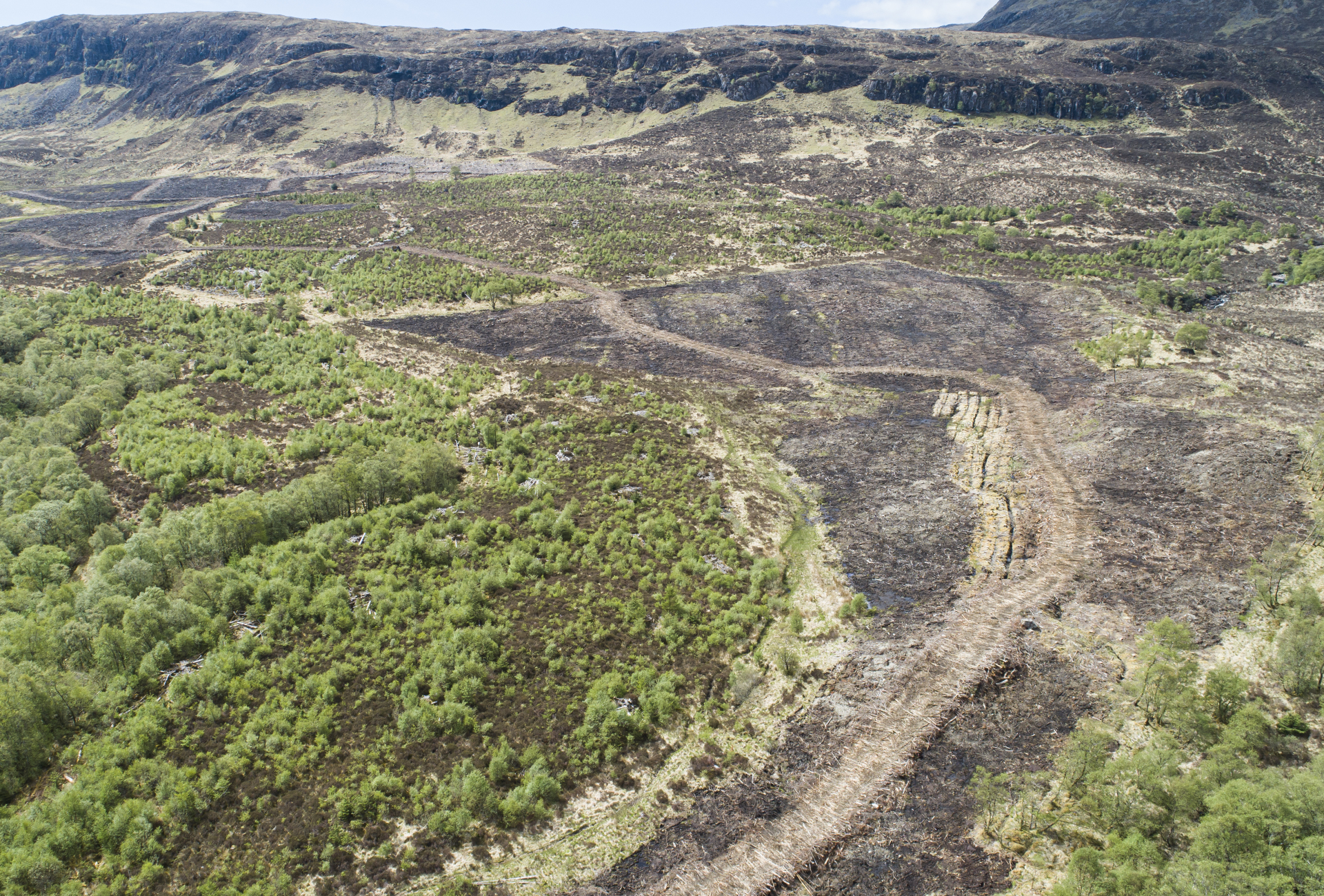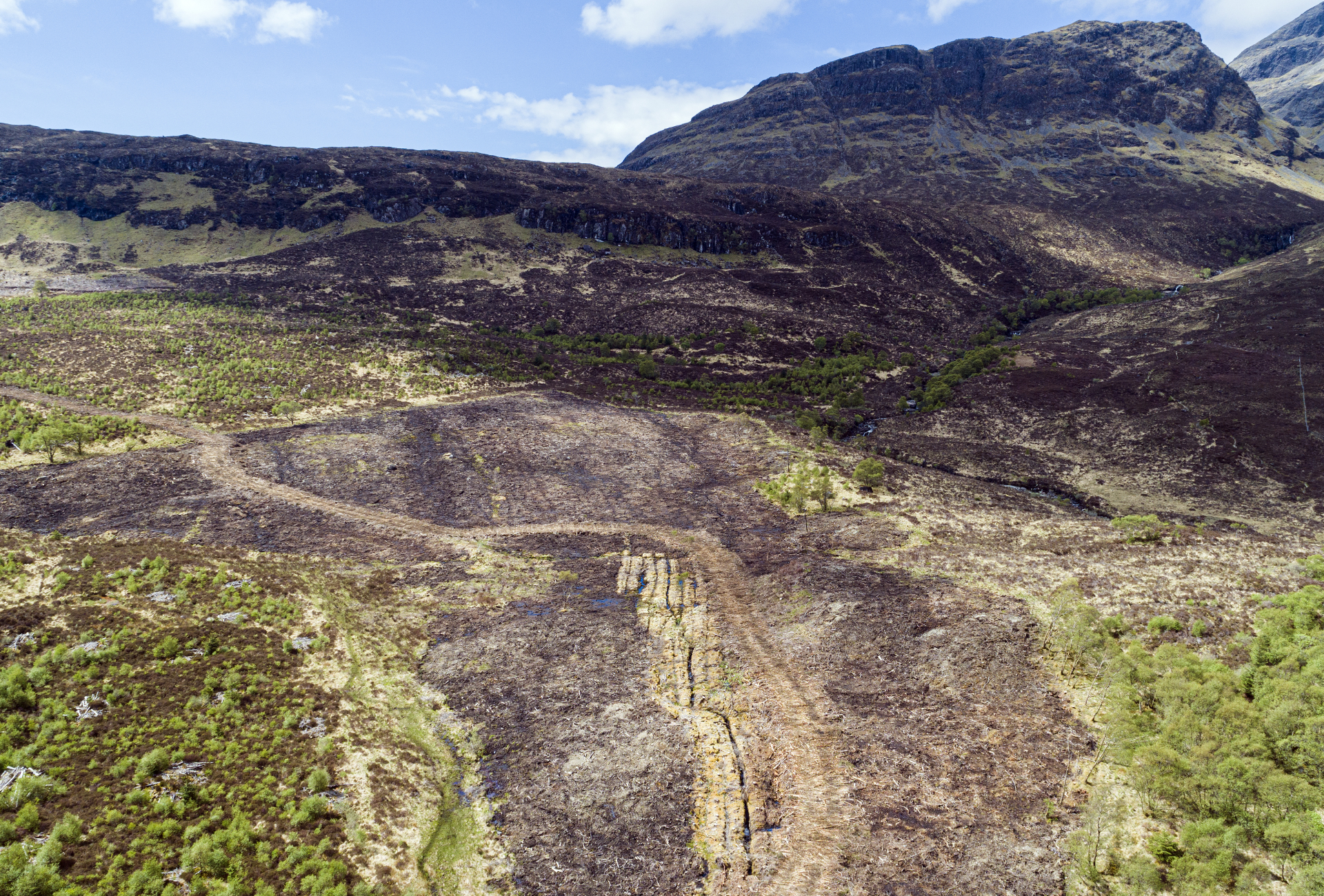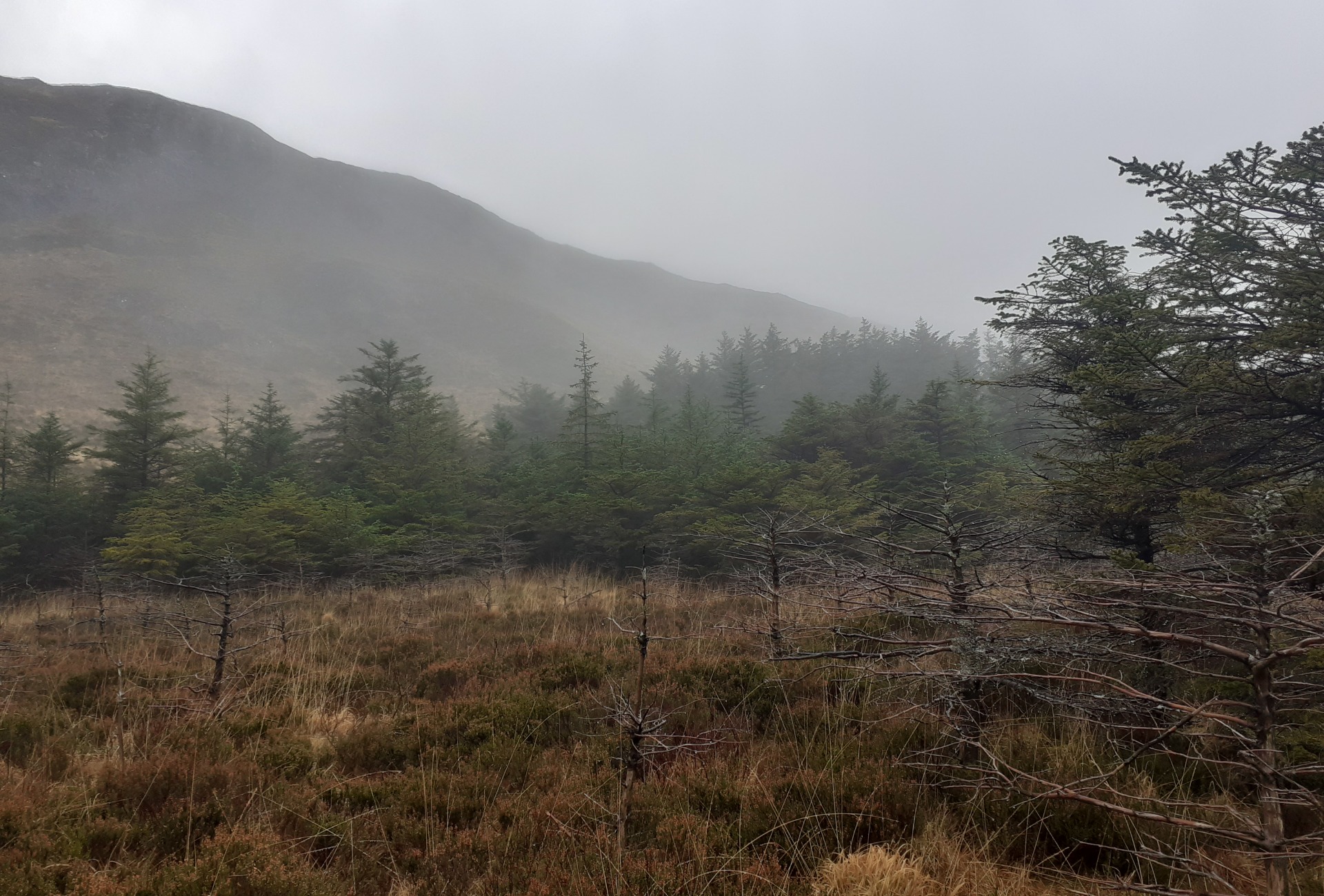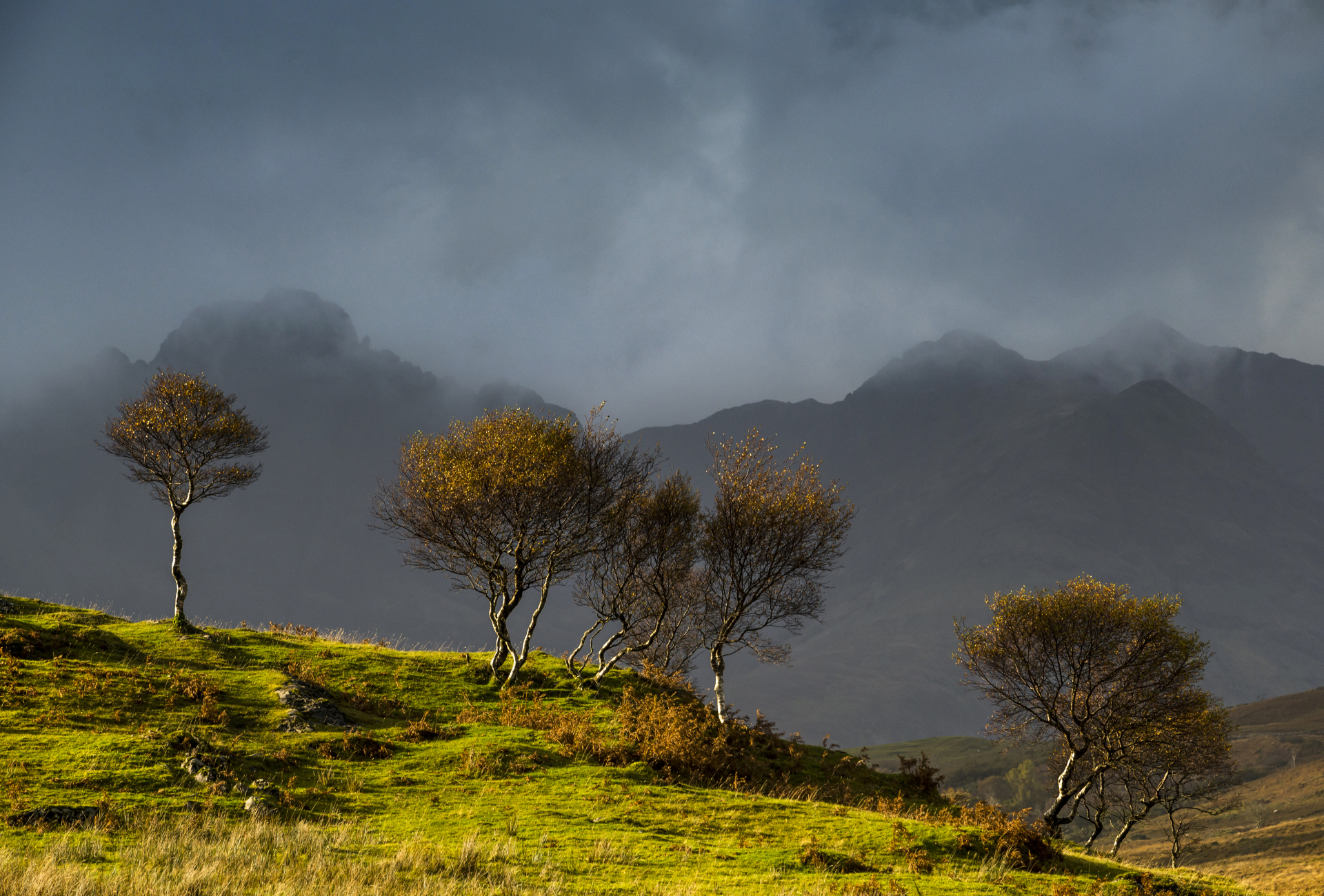Acting small thinking big: Nature-based solutions to the carbon crisis
From a bog in Skye to a bold proposal for Holyrood, this World Environment Day (5 June) we share our big-picture thinking on carbon.
Two bright orange excavators sit stark against the damp brown tones of the forest clearing. Felled trees are scattered like snapped matchsticks around them.
To a passer-by this resembles the hangover of another commercial spruce felling operation.
“It might not look like it now, but we know that what we’re doing here will help speed up the recovery of this peatbog,” says Ally Macaskill, the John Muir Trust’s Land Manager on the Isle of Skye. “When it gets back to its natural state, this will be an area that captures and stores carbon from the atmosphere, provides a home and food for wildlife, and helps prevent flooding and soil erosion elsewhere. It will offer us all these essential services for free, forever, if we just let it recover.”
The work on Skye started earlier this year, incidentally the first year of the United Nation's Decade on Ecosystem Restoration - a ten-year project aimed at fixing a broken planet. The UN highlights the critical role that intact peatland, woodland, rainforest and grassland play in mitigating the effects of a carbon-choked world.
Alongside other natural solutions, repairing degraded ecosystems could deliver one third of the mitigation needed by 2030 to keep global warming below two degrees Celcius [1].
Ally and the team on Skye are working to restore 36.5 hectares of degraded peatland.
Studies [2] highlight that deep peat soils can store eight times as much carbon as an equivalent area of tropical rainforest – “so while it’s a drop in the ocean compared to what we need across the UK, operating at a smaller scale will allow us to deliver the evidence for larger scale contributions in the future across, public, private and other environmental charity landholdings,” says Ally.
As a wild land charity, we’re investing a lot into a road map that gets us from status quo to becoming exemplary managers of land for wildlife, people, carbon and ultimately the climate crisis.
What does this look like?
- Action on the ground – such as the peatland restoration work on Skye
- Walking the talk – looking at the carbon impact of our internal actions as an organisation
- Thinking big - proposing a bold new ‘natural land carbon tax’ which could help deliver natural carbon capture across Scotland at the scale that is urgently needed if we are to make an impact on our targets.
- Thinking wilder – partnering to develop ‘carbon credits’ that are about more than just planting trees
Action on the ground - restoring peatland
Peatlands are the world’s largest terrestrial carbon store, capturing more than all of the Earth’s forests combined. They cover only three per cent of our planet’s surface yet they account for 30 per cent of the world’s carbon store.
The UK’s peatlands currently store more than three billion tonnes of carbon.
But 80 per cent of Scottish peatlands are damaged. Drained and burned for forestry, agriculture; trampled by sheep and deer, and built on for ‘green’ energy our precious peatlands have suffered centuries of abuse. When peat dries out, the organic matter is open to the air and starts to decompose, emitting harmful greenhouse gases.
Together with a range of other partners, including NatureScot, we have identified three areas for peatland restoration on Skye - Faoilean, Ringill and Sligachan - with work currently ongoing across an area equivalent to 50 football fields.
“What we’re doing on Skye is small scale,” says Ally, “but we’ve got a responsibility to unlock the potential of the peat bogs on the land we look after. Soon we hope to be able to calculate just how much carbon these bogs are locking up.”
Walking the talk – being carbon credible
We want to be a 'carbon credible' organisation.
Why not ‘net zero?’
Net zero puts a lot of emphasis on balancing carbon capture with reducing the production which provides opportunities polluters to continue providing there is sufficient offset. We intend to reduce our carbon emission to lowest practical levels, in all aspects of our varied operations, from land management to policy, engagement to fundraising.
So it isn’t just about how much carbon a restored peatland area on Skye can hold, it’s about how we approach that restoration work in the first place. The bright orange excavators on site aren’t electric yet.
To move towards carbon credibility, we first needed to assess our carbon footprint baseline. To do this, we engaged Small World Consulting (whose client logos include forward-thinking brewers BrewDog and Trust corporate member Mountain Equipment). We then reached out to Loch Lomond and Trossachs National Park, which has developed its own carbon credible roadmap.
Building upon this work, we have hired a dedicated Carbon Officer to develop and manage an emissions descent trajectory, which all in the Trust will need to engage with to get to as close to zero as soon as possible.
Thinking big – it’s like a sugar tax, but for carbon…
If all land managers in Scotland maximised carbon capture of their peatlands and woodlands, we could reduce our national carbon emissions by up to 13 Mt CO2e a year - that’s equivalent to removing every single vehicle from Scottish roads.
“Scotland has an abundance of low productivity land which could be locking up vast quantities of carbon each year, while improving biodiversity and stimulating rural economies,” says Mike Daniels, Head of Policy and Land for the John Muir Trust.
That’s why we’re advocating for a banded tax on landholdings, based on actual and potential carbon emissions.
Those maximising natural carbon capture on their land (through woodlands or intact peatlands for example) would be exempt from the charges, and landowners eligible for the tax would be able to move to lower tax bands by changing land use to maximise carbon capture.
Taxes raised would help fund natural carbon capture work across the country – the carbon equivalent of using the sugar tax to help tackle the obesity crisis.
When we published this proposal in early 2021, there was constructive and supportive feedback from scientists, political parties and climate change experts around the UK. We are taking this feedback on board in developing a revised version which will be published in time for COP26 – when the world’s eyes will be on the UK.
Thinking wilder – carbon credits for holistic land management
Wilder Carbon are a fledgling company that are developing an innovative funding mechanism for businesses to make ethical carbon investments in local nature restoration projects across the UK.
While investments are currently focused on woodland and some peatland projects, we’re working with Wilder Carbon to apply this mechanism to more holistic land management, potentially developing ‘carbon credits’ that take into account natural restoration, biodiversity and community benefits – rather than just planting trees.
For somewhere like Skye, this could mean Ally’s future peatland restoration work being funded by big business, and future opportunities for crofting land benefiting from carbon credits.
[1] Carbon Storage and Sequestration by Habitat 2021
[2] Griscom et al., 2017; Kapos et al., 2019
